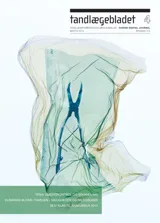Behandling af akutte pulpale og periapikale smerter
At kunne mestre akut odontogen smertebehandling er centralt i vores profession samt tillidskabende i forhold til patienten. En rationel behandlingsstrategi skal relateres til, om der er tid til at udføre den endelige behandling, eller om man i første omgang primært skal smertelindre. Opdatering af bedøvelsesprocedurer belyses, og det bemærkes, at i godt 1/3 af patienttilfældene kan bedøvelseseffekt først erkendes efter mere end 15 min. Akut oplukning (nød-pulpotomiindgreb) uden instrumentering af kanalerne synes at være smertelindrende både i relation til den akutte pulpitis og den smertegivende apikale parodontitis (hævelse og pus ikke medtaget). Anvendelsen af en delvis pulpektomiprocedure kombineret med diverse medikamenter kan ikke anbefales. Antibiotika giver ingen smertelindrende effekt ved akut pulpitis og bidrager ej heller til ekstra smertelindring, hvis konventionel behandling af den apikale parodontit er udført. I langt de fleste situationer er postoperative endodontiske smerter relateret til persisterende bakterielle kontamineringer, hvor behandling kan veksle mellem konventionel og kirurgisk revision, men også ekstraktion. Den biologiske basis for den høje succesrate hvad angår vital pulpa-smertelindring ved anvendelsen af relativt simple indgreb skyldes, at indgrebene er effektive til at reducere vævsniveauet af inflammatoriske metabolitter, herunder det forhøjede interstitielle vævstryk, som stimulerer de perifere terminale smertereceptorer.
Treatment of acute pulpal and periapical pain: To master an emergency pain strategy is central within our pro- fession and will create a relationship in which the patient has confidence in the dentist. A rational strategy must be related to whether there is time to carry out the final treatment or whether the time only allows a pain relieving procedure. An update in relation to local anaesthesia will be given. Note, that for 1/3 of the patients the optimal effect will be reached after as long as 15 min. latency time or more. The emergency-pulpotomy without negotiating the root canals seems to be an effective and simple pain relieving procedure in relation to both the vital pulp as well as the necrotic pulp (swelling and pus cases not included). The use of a partial pulpectomy procedure combined with various medicaments cannot be recommended. Antibiotics will not reduce pain in relation to pulp inflammation. Antibiotics will not create additional pain relief, if conventional treatment is carried out. In the vast majority of endodontic post operative cases, pain can be related to a persistent microbial contamination. The treatments may include not only conventional and endodontic retreatments, but also extraction of the tooth. The biological basis for the high success following emergency pulpotomy procedures in teeth is related to the reduction both in tissue pressure and in the level of inflammatory metabolic substances which initially have activated the peripheral terminal pain receptors.


